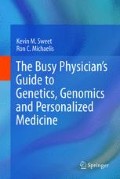Abstract
The human DNA sequence is highly polymorphic; for a typical gene, different people have different specific sequences (or alleles) for that gene. As a result, for the typical protein, different people have different levels of activity in that protein. If the activity of a protein is significantly greater or less than the level of activity that is seen in the typical person, that individual will have a greater or lesser susceptibility to the diseases the protein’s function influences than the typical person does. Whether a high-activity or low-activity gene allele represents a risk-increasing allele or a risk-decreasing allele depends on the specific function the protein performs. While some risk-increasing alleles are relatively common, and some increase the individual’s risk for the associated disease dramatically, most risk-increasing alleles are relatively rare, and most only increase the individual’s risk for the associated disease by a small amount. This chapter contains a thorough review of the foundational material that the reader must understand in order to understand the aforementioned principles. This includes a review of the process whereby a gene makes a protein, the role of promoter and other regulatory sequences in influencing gene activity, and the role that intronic sequence variants, interfering RNAs and epigenetic factors play in regulating gene activity.
Access this chapter
Tax calculation will be finalised at checkout
Purchases are for personal use only
Notes
- 1.
The carbons in the base are given the numbers 1, 2, 3, etc. In order to distinguish between the carbons in the base and the sugar, the carbons in the sugar are designated as 1′, 2′, 3′, etc.
- 2.
Most RNAs then go on to make proteins, but some RNAs function as enzymes (ribozymes), play critical roles in protein synthesis (rRNA and tRNA) or regulate the production of other genes’ proteins (microRNAs).
- 3.
The term “locus” is frequently used to refer to a stretch of sequence in the DNA molecule. The term is used very broadly; there is no specific length or sequence requirement for a stretch of DNA to be a locus. A locus can be a single nucleotide, or a string of nucleotides of any length.
- 4.
There is no length or sequence requirement for a stretch of DNA to be considered an allele, either. Any version of a locus’s or gene’s sequence, whether it differs from other versions by a single nucleotide or many, is referred to as an allele of that locus/gene.
- 5.
This discussion of spermatogenesis and oogenesis omits some important details, as well as some important differences between the two processes. It is merely intended to illustrate the inheritance of polymorphic gene alleles.
- 6.
This is not an exhaustive description of the transcription or translation process. We merely emphasize those points that have some direct relationship to personalized medicine.
- 7.
We are not proposing this as the standard system of terminology for the field. This is merely a useful system of terminology for the purposes of this book.
- 8.
Serotonin’s chemical name is 5-hydroxytryptamine, or 5HT. Therefore the 5HT transporter gene is referred to as 5HTT.
- 9.
The rearrangements we speak of here are not the exchange of material between recombining chromatids in meiosis. These rearrangements involve breakage of the entire chromosome, and either reinstatement of the excerpted piece in the opposite orientation, or exchange of material between different chromosomes, not between chromatids from the same chromosome.
- 10.
When perusing published works, you will often find the gene’s name written in italics, and the name of the protein written in regular font.
Further Readings
Auffray C, Chen Z, Hood L (2009) Systems medicine: the future of medical genomics and healthcare. Genome Medicine 1(1): 2.
Bartel, DP (2009) MicroRNAs: target recognition and regulatory functions. Cell 136(2): 215–33.
Cuccato G, Della Gatta G, di Bernardo D (2009) Systems and Synthetic biology: tackling genetic networks and complex diseases. Heredity 102(6): 527–32.
Izquierdo M (2005) Short interfering RNAs as a tool for cancer gene therapy. Cancer Gene Ther 12 (3): 217–27.
Mattick JS and Gagen MJ (2001) The Evolution of Controlled Multitasked Gene Networks: The Role of Introns and Other Noncoding RNAs in the Development of Complex Organisms. Molecular Biology and Evolution 18(9): 1611–1630.
Schneider JA, Pungliya MS, Choi JY, Jiang R, Sun XJ, Salisbury BA, Stephens JC (2003) DNA variability of human genes. Mechanisms of Ageing and Development 124(1): 17–25.
Simmons D (2008) Epigenetic Influences and Disease. www.nature.com/scitable/topicpage/epigenetic-influences-and-disease-895.
The 1000 Genomes Project Consortium (2010) A map of human genome variation from population-scale sequencing. Nature 467: 1061–1073.
Zhang F, Gu W, Hurles ME, and Lupski JR (2009) Copy Number Variation in Human Health, Disease, and Evolution. Annual Review of Genomics and Human Genetics Vol. 10: 451–481.
Author information
Authors and Affiliations
Corresponding author
Rights and permissions
Copyright information
© 2011 Springer Science+Business Media B.V.
About this chapter
Cite this chapter
Sweet, K.M., Michaelis, R.C. (2011). Genetic Variability Provides the Biochemical Basis for Our Individuality, Including Differences in Our Susceptibility to Many Common Diseases. In: The Busy Physician’s Guide To Genetics, Genomics and Personalized Medicine. Springer, Dordrecht. https://doi.org/10.1007/978-94-007-1147-1_1
Download citation
DOI: https://doi.org/10.1007/978-94-007-1147-1_1
Published:
Publisher Name: Springer, Dordrecht
Print ISBN: 978-94-007-1146-4
Online ISBN: 978-94-007-1147-1
eBook Packages: Biomedical and Life SciencesBiomedical and Life Sciences (R0)

